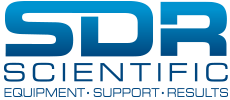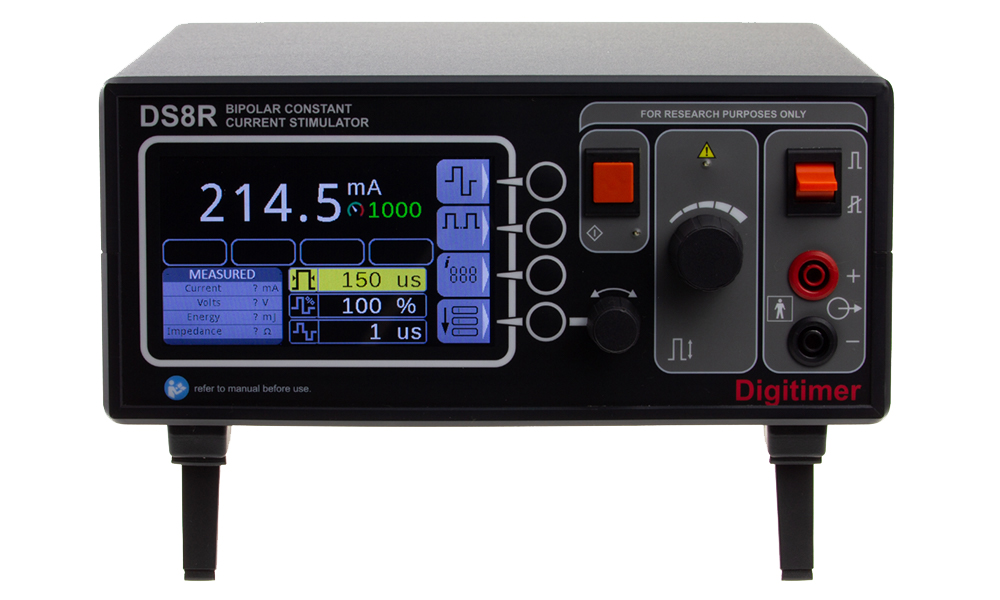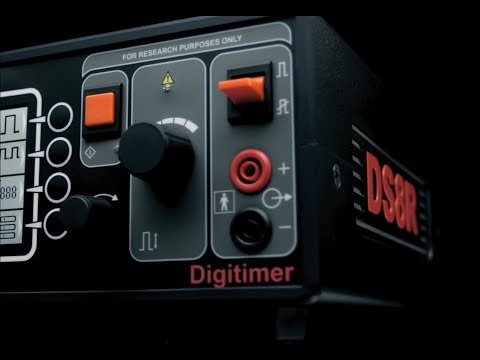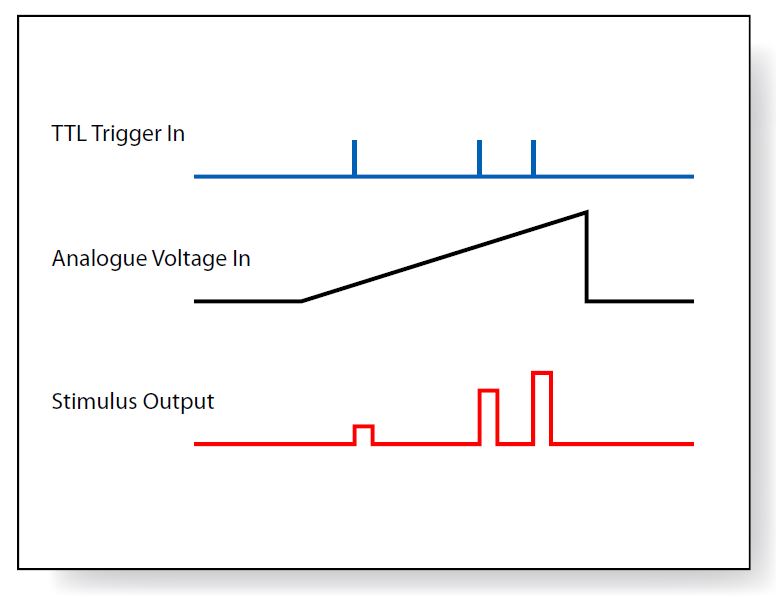DS8R Biphasic Constant Current Stimulator
The Digitimer DS8R – A New Tool for Sensory Threshold Stimulation
The DS8R from Digitimer UK is a new constant current, multi-mode, discrete pulse stimulator for human research studies involving nerve and muscle stimulation via surface electrodes. It has two pulse modes, enabling stimulation using monophasic or biphasic rectangular pulses. This Isolated Bipolar Stimulator provides life science researchers with the ability to deliver biphasic, charge-balanced stimuli under manual or software control.
It features a high compliance voltage and can be triggered by a TTL compatible input, contact closure foot/hand switch or front panel “single-shot” button. The DS8R can deliver monophasic or biphasic pulses of up to 2ms duration and up to 1000mA (from 400V), however the actual current achieved will be restricted by a pulse energy limit of 300mJ per pulse and the skin/electrode resistance.
DS8R has a current amplitude limit or lock, which allows the operator to temporarily set the maximum current level to something other than the default 1000mA. This feature is of importance to any DS8R users working at the lower end of the current output range, as they understandably want to avoid accidental delivery of excessively high stimuli to their subjects. Using a simple press-and-hold feature added to the amplitude dial, it is now possible for a user to activate and deactivate an output current limit of between 10mA and 999mA.
If an operator sets the output range to 0-10mA using the current amplitude limit, the rear panel Control Input is re-scaled accordingly. This not only makes it impossible for a voltage applied at this input to cause the current to exceed 10mA, but also gives the user finer control over the output amplitude.
The new DS8R incorporates features that allow external “on the fly” control of stimulus pulse parameters.
Biphasic Charge-balanced Output
The DS8R has two pulse modes, enabling stimulation using monophasic or biphasic rectangular pulses. Additionally, in biphasic mode the DS8R allows for both symmetric or asymmetric charge-balanced stimuli through implementation of an adjustable stimulus/recovery phase amplitude ratio. Biphasic charge-balanced stimulation offers certain advantages over monophasic stimulation, as it prevents the potentially harmful electrochemical changes which occur under stimulation sites and is reported to be more comfortable for the subject during long periods of stimulation. The recovery phase ratio can be adjusted from 10% to 100% in 1% increments.
External Control Capabilities – Software (via USB) and Analogue Voltage Input
With the DS8R Researchers can adjust stimulus settings (current and duration) during a stimulation protocol.
This versatile stimulator can not only be operated as a standalone isolated stimulator with full control via the front panel, but settings can also be modified using a supplied Windows PC control software via a USB interface. This software provides a Virtual Front Panel for the stimulator, but more importantly incorporates an API allowing the operator to implement control from custom or commercially available software packages
Pulse current amplitude can be more simply controlled via an analogue voltage input (BNC) on the rear of the DS8R. Using this method of control, the DS8R monitors the voltage applied at this input (0-10V) and adjusts the stimulus current (0-1000mA) proportionally with this voltage as each trigger input is detected. The control voltage signal is used as a proportional representation of the output stimulus current.
Applications:
The DS8R is suitable for human research applications only and is not currently registered for clinical use. DS8R applications include:
- High frequency transcutaneous spinal cord stimulation: This method requires the modified firmware and is of interest to researchers involved in the potential modulation and recovery of spinal cord function in SCI/paraplegia. There is some evidence that the high frequency stimulation is better tolerated as it does not activate c-fibres but can still have an effect on the spinal cord.
- Psychology research – Automated control of stimulus intensity so that tests can be automated without operator having to make manual adjustments.
- Pain and perception testing – Similar to the above application, where software can be used to pre-define stimulation protocols.
- Used with Digitimer D188 Remote Electrode Selector – to stimulate different sites and at different current intensities. This can allow a single DS8R and D188 to replace multiple DS7A’s in some applications.
- Remote control of stimulation when it is used in conjunction with fMRI imaging.
6. Programmable/automated stimulation of Trigeminal, Vagus nerves or other nerves when examining different treatment areas for TENS.
Technical Specifications:
- Current range: 0 to 1000mA, in 0.1mA steps, from up to 400V
- Current Output Limit (user set between 10mA and 999mA)
- Pulse duration range: 50-2000µs
- Biphasic Output: Charge-balanced symmetric or asymmetric
- Adjustable inter phase interval: 1-990µs
- External control: via PC software/USB connection (includes API)
- Stimulus current Control: Analogue
- Output connection accessories: Plugs and cables and electrodes
What are the Key Features & Benefits
- The DS8R allows for a greater degree of external control than other stimulators. The addition of a truly biphasic output is a useful feature, to prevent polarisation and electrochemical damage to the stimulation site and there is evidence that biphasic stimuli can result in a smaller stimulus artefact.
- No other stimulator in the market offers the same advanced control options along with the 1A/400V output, which tends to set the DS7 family and DS8R apart from other devices.
- A special edition optional firmware can also be provided for researchers interested in stimulating at higher frequencies (10kHz) than the standard unit permits.
The DS8R can now deliver stimuli as low as 100µA, making it fully compatible with human research involving transcutaneous stimulation within sensory threshold levels.
Links to source webpages
https://digitimer.com/products/human-neurophysiology/peripheral-stimulators-2/ds8/
Links to any references, papers
https://scholar.google.co.uk/scholar?hl=en&as_sdt=0%2C5&q=Digitimer+DS8R+OR+DS8&btnG=




